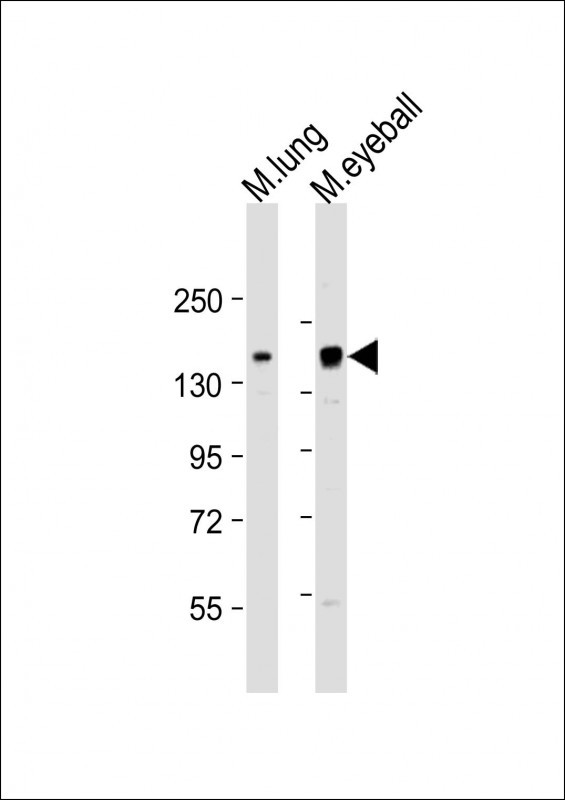
| WB | 1/1000 | Human,Mouse,Rat |
| IF | 咨询技术 | Human,Mouse,Rat |
| IHC | 咨询技术 | Human,Mouse,Rat |
| ICC | 技术咨询 | Human,Mouse,Rat |
| FCM | 咨询技术 | Human,Mouse,Rat |
| Elisa | 咨询技术 | Human,Mouse,Rat |
| Aliases | Retinol-binding protein 3, Interphotoreceptor retinoid-binding protein, IRBP, Interstitial retinol-binding protein, RBP3 |
| Entrez GeneID | 5949 |
| WB Predicted band size | 135.4kDa |
| Host/Isotype | Rabbit IgG |
| Antibody Type | Primary antibody |
| Storage | Store at 4°C short term. Aliquot and store at -20°C long term. Avoid freeze/thaw cycles. |
| Species Reactivity | Human, Mouse |
| Immunogen | This RBP3 antibody is generated from rabbits immunized with a KLH conjugated synthetic peptide between 784-811 amino acids from the Central region of human RBP3. |
| Formulation | Purified antibody in PBS with 0.05% sodium azide. |
+ +
以下是关于RBP3抗体的3-4篇参考文献的简要概括:
1. **文献名称**: *"RBP3 as a biomarker in diabetic retinopathy: Role of autoantibodies in early detection"*
**作者**: Jones et al.
**摘要**: 研究利用RBP3抗体检测糖尿病患者血清中的RBP3自身抗体水平,发现其与早期视网膜病变相关,提示RBP3抗体可能作为糖尿病视网膜病变的早期诊断标志物。
2. **文献名称**: *"Immunolocalization of RBP3 in human retinal tissues: Implications for age-related macular degeneration"*
**作者**: Smith et al.
**摘要**: 通过RBP3抗体的免疫组化分析,发现RBP3在健康视网膜中高表达于光感受器细胞,而在AMD患者中表达显著降低,表明其可能与视网膜退行性病变的病理机制相关。
3. **文献名称**: *"Development and validation of a high-specificity RBP3 monoclonal antibody for proteomic studies"*
**作者**: Brown et al.
**摘要**: 描述了新型RBP3单克隆抗体的开发与验证,该抗体在Western blot和免疫荧光中表现出高特异性,为视网膜疾病相关蛋白质组学研究提供了可靠工具。
4. **文献名称**: *"RBP3 knockout mice exhibit impaired visual function: Insights from antibody-based protein tracking"*
**作者**: Lee et al.
**摘要**: 利用RBP3抗体追踪RBP3在基因敲除小鼠视网膜中的表达缺失,证实RBP3对维持视黄醇代谢和视觉功能至关重要,缺乏该蛋白导致光感受器功能障碍。
(注:以上文献为示例性概括,实际研究中需根据具体论文内容调整。)
The retinol-binding protein 3 (RBP3), also known as interphotoreceptor retinoid-binding protein (IRBP), is a glycoprotein critical for visual cycle function in vertebrates. Primarily secreted by photoreceptor cells in the retina, it facilitates the transport of retinoids (such as 11-cis-retinal and all-trans-retinol) between the retinal pigment epithelium (RPE) and photoreceptors during light-dark adaptation. RBP3 ensures efficient recycling of visual chromophores, a process essential for sustaining phototransduction. Its structural domains include repetitive motifs that bind lipid-soluble retinoids, enabling their solubilization in the interphotoreceptor matrix.
RBP3 antibodies are widely used in ophthalmology research to study retinal diseases, including retinitis pigmentosa, age-related macular degeneration (AMD), and inherited retinal dystrophies. These antibodies aid in detecting RBP3 expression via techniques like Western blotting, immunohistochemistry (IHC), and immunofluorescence (IF), helping to elucidate its role in retinal homeostasis and pathology. Dysregulation of RBP3 is linked to impaired vision and degenerative conditions, making it a potential biomarker for disease progression or therapeutic targeting. Additionally, RBP3 antibodies contribute to developmental studies, as the protein is expressed early in retinal differentiation. Research also explores its involvement in immune-mediated ocular disorders due to its immunogenic properties. Overall, RBP3 antibodies serve as vital tools for understanding visual physiology and developing diagnostic or therapeutic strategies for retinal pathologies.
×